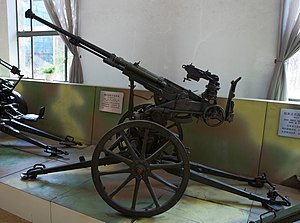|
Type 98 20 mm AA machine cannon
 The Type 98 20 mm AA machine cannon was the most common light anti-aircraft gun of the Imperial Japanese Army. It entered service in 1938 and was used until the end of World War II. After World War II this gun was used by the Indonesian Army in the Indonesian National Revolution and North Vietnam in First Indochina War. Design and useThe Type 98 20 mm AA machine cannon was the most common light anti-aircraft gun of the Japanese military.[1] The Type 98 designation was given to this gun as it was accepted in the year 2598 of the Japanese calendar (1938).[5] It entered service that same year and first saw combat in Nomonhan. It was used until the end of World War II.[1] About 80% of the Imperial Japanese Army light AA guns were Type 98s.[1] The gun could be emplaced in about three minutes by an experienced crew or fired inaccurately from its wheels. It was also used as an anti-tank weapon, it was considered to be robust, light, and easily portable.[6] This weapon and its variants were based on the French design of the 13.2 mm Hotchkiss machine gun of the 1930s, which the Japanese forces had bought and further developed at home. The Type 98 was also one of the two armament options for the IJA's Submersible gun mount Model 1. Ammunition
VariantTwo of the guns mounted together formed a variant known as the Type 4 20 mm twin AA machine cannon. Approximately 500 to 548 of these guns were produced.[2][3] See also
References
Bibliography
External links |
||||||||||||||||||||||||||||||||||||||||||||||||||||
